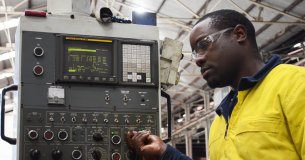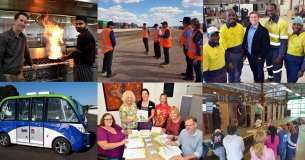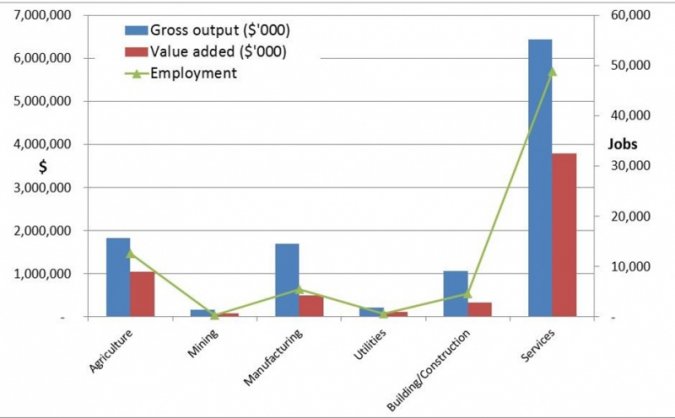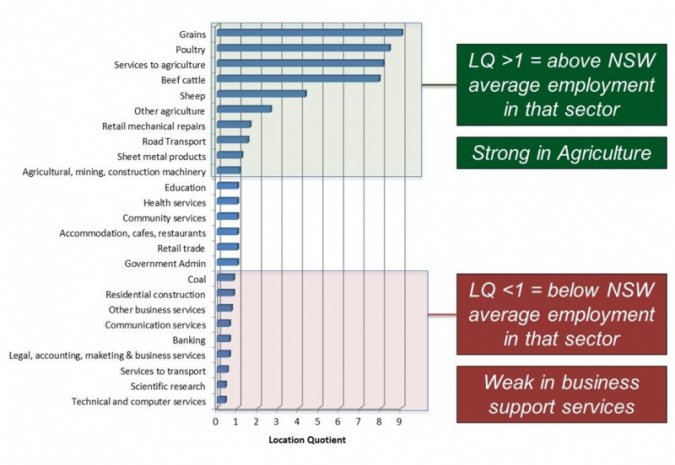-
Featured Items
-
Featured Resources
 Funding & Grants
Don't miss out on funding opportunities. Stay informed with our up to date online listings and email notifications.
Read More
Funding & Grants
Don't miss out on funding opportunities. Stay informed with our up to date online listings and email notifications.
Read More
 Skilled Migration
Our services help both applicants and employers, to learn more, develop plans, submit applications, and settle in.
Read More
Skilled Migration
Our services help both applicants and employers, to learn more, develop plans, submit applications, and settle in.
Read More
 Research and Analysis
Good research and analysis makes the case. How can our resources and services help your project or application?
Read More
Research and Analysis
Good research and analysis makes the case. How can our resources and services help your project or application?
Read More
 Information & Data Resources
With resources like REMPLAN, Regional Knowledge Base, and decades of data, discover how we can help your project.
Read More
Information & Data Resources
With resources like REMPLAN, Regional Knowledge Base, and decades of data, discover how we can help your project.
Read More
-
Stay InformedSubscribe to one or more of our regular email subscriptions, to be kept up to date on news and funding opportunities for the region
-
-
Our Region
- Our Region
- Regional Plan
- Regional Data
- Current Regional Issues
- Population Migration Analysis for 2016-21
- Job Vacancies Continue at All-Time High
- National Debt - What it Means for Our Economy?
- The True Value of Home Solar
- The Economic Impacts of Local Government Amalgamations
- State of the Regions Report 2014-15
- Antifragility - A different take on regional economic development
- Biohubs - Collaborative Waste Management
- Attracting New Residents
- Socio-Economic Impacts of the Murray Darling Basin Plan
- Murray Darling Basin Water Recovery
- Growing Businesses
- The Northern Inland Economy
- Geographical Overview
- Major Industry Sections
- Our Services
- Grants and Funding
-
Skilled Migration
- Skilled Migration
- Skilled Employer Sponsored Regional Visa
- Skilled Work Regional Visa (subclass 491)
- Temporary Seasonal Workers
- Designated Area Migration Agreement (DAMA)
- Helpful Information for Visa Holders
- Information for Employers
- Case Studies
- Payment Details
- Advice & Further Information
- Contact Details
- News & Events
-
Our Projects
- Our Projects
- Current Projects
- Skilled Migration
- Wool Works - Wool Training Schools
- Metal Works - Welding and Fabrication Schools
- Come On Inland
- Stories of Resilience
- Alt Brothers Beekeeping - Glen Innes
- Carelle's Toy Store - Glen Innes
- Greenhill Orchards - Arding
- Gwydir Meats - Warialda
- Kaputar Motors - Narrabri
- Moonbi General Store - Moonbi
- Sandstock - Tingha
- Sherelle Fashions - Tenterfield
- Sleepy Merino - Inverell
- Tenterfield Chamber of Toursim, Industry and Business - Tenterfeild
- The Welders Dog - Armidale
- Walcha Veterinary Supplies - Walcha
- AGCAP - Agribusiness Careers & Professions
- Northern Inland Regional Investment Profile
- Past Projects
- Digital Economy Strategy
- Business Growth Project
- Go Digital
- How to Start an Online Business
- Create Your Website Using Squarespace
- How to Edit Your Squarespace Site - Part 1
- How to Edit Your Squarespace Site Part 2
- Add a Shop to Your Squarespace Site
- Start a Blog and Find out What Customers are Searching
- 14 Tips For a Better Blog Post
- Which Social Media Platforms are Best for Your Business
- How to Use Facebook Effectively For Your Business – Part 1
- How to Use Facebook Effectively For Your Business – Part 2
- Instagram Tips for Business
- Catching Up, More Instagram & Dealing with Haters
- Getting Started with Twitter for Business
- Social Media Scheduling Tools
- How to Start an Etsy Shop – Part 1 – Research
- How to Start an Etsy Shop – Part 2 – Signup
- Online Security for Your Business
- Product Photography and Website Images: Your Guide
- 5 Tips to Improve your Productivity in your Business
- Best Online Business Resources
- How to Improve Your Communication Skills and Win More Clients
- NBN Coordinator
- Putting Power Back in the Regions
- Road Freight Study
- Town Audit Benchmarks
- Food and Wine
- Youth Survey
- Digital TV Switchover Assistance
- Northern Inland Transport Guide
- Live.Train.Work
- Northern Inland Innovation Awards
- Northern Inland Innovation Awards - 2017
- Northern Inland Innovation Awards - 2016
- Northern Inland Innovation Awards - 2015
- Northern Inland Innovation Awards - 2014
- Northern Inland Innovation Awards - 2013
- Northern Inland Innovation Awards - 2012
- Norther Inland Innovation Awards - 2011
- Prime Super Northern Inland Innovation Awards - 2010
- Prime Super Northern Inland Innovation Awards - 2009
- Northern Inland Innovation Awards - 2007
- Northern Lights Project
- NBN Smart Home
- Murray Darling Basin
- Moree Plains Business Workshops
- Namoi Investment Prospectus
- Industrial Land
- Bioenergy and Local Electricity Retailing
- Northern Inland Business Energy Assessment
- Skills for the Future
- Impacts of COVID-19 on Businesses
- Past Projects of NIRDB
- Aboriginal Employment and Enterprise in the Gunnedah Region
- Art as an Industry
- Aviation Survey
- Farm Forestry - Northern Inland Forestry Investment Group
- New England North West Film Strategy
- Northern Inland Excellence in Business Awards
- Food and Wine 2003 - 2008
- Prime Super Northern Inland Innovation Awards 2009
- Regional Business Networking Program
- Regional Leadership Course 2008
- Viticulture Strategy 2002-2003
- About Us
- Contact Us
- Other Resources
- Privacy and Legal
- Search
- Our RegionOur Region
- Current Regional IssuesCurrent Regional Issues
- The Northern Inland EconomyThe Northern Inland…
The Northern Inland Economy
What Does It Look Like, How Can We Grow It?
Agriculture – Still a Big Deal
The economic comparative advantage of our region lies in the natural resource base – land, water and increasingly minerals. Any way you look at it, agriculture is still a dominant force in our economy, and anything which impacts on farming has flow-on effects to other businesses.
From Figure 1, you might conclude that the services sector (wholesale & retail trade, mechanical repairs, accommodation, cafes, transport, communications, finance, legal, accounting, marketing, government, education, health) dominates, but those sectors largely exist to service the needs of the other five ‘production’ sectors, of which agriculture is the largest.
Some of our towns are more specialised in agriculture than others, Moree for example. A study of the Moree economy has revealed that the gross value of production in the shire fell by almost 50% during severe drought. Compare that to the 7% impact the closure of the steelworks in Newcastle had.
The Diversification Conundrum
Economies reliant upon natural resources and ‘commodities’ face some challenges. Natural resources are subject to on-going policy change. Commodities are subject to the vagaries of climate and international price fluctuations. A good agricultural season benefits most sectors in our economy, but a poor season can be disastrous.
It would be good to have some new industry options which are not at the mercy of the weather and commodity price cycles, such as technology and knowledge based industries which service markets outside the region and internationally. Finding markets outside the region is essential, given our population is not growing as rapidly as in other markets.
However, regional areas have been seeking diversification opportunities for decades and by and large, results have been disappointing. One reason is the lack of business support services. Technology and knowledge based businesses need rapid access to a range of services which are typically only found in major metropolitan centres. Businesses are not willing to re-locate for fear of losing access to these services, and the synergies they achieve by having other businesses in their supply chain in close proximity. Perhaps for some businesses, the NBN rollout may help in this regard?
The Location Quotients shown in Figure 2 measure employment levels in each sector of the economy, relative to the State as a whole. We are strong in agriculture and agricultural support services, but weak in areas like finance, accounting and IT – sectors which support businesses. We are also weak in the technology and knowledge based sectors – sectors which have highly qualified and well paid employees. Well-paid jobs mean higher household incomes and more expenditure in other local businesses.
Are There Any Solutions?
Expecting a new industry to materialise and solve our problems is a long-shot. Mining expansion does fall into this category, but it comes with challenges including attracting labour away from other industries, pressure on transport, pressure on local government, and the multiplier effects from mining are about half those generated by a local business, as many inputs are sourced from outside the region.
In the U.S., it took several decades for the regional economic development fraternity to realise that their best option was to find existing local businesses with the capacity for significant growth. They have gone down that path with some remarkable success stories (e.g. the town of Littleton), but there are no easy wins. It takes time and resources to identify businesses with potential and to help them to grow. Only a small percentage will have the capacity for significant growth.
Small to medium size businesses are driving employment growth in the U.S., while the large corporates are shedding jobs. The same is happening in Australia. The U.S. experience revealed that access to capital was often not the major hurdle, but rather the need to develop business management skills and to find new markets was the key to small business growth.
There is also the concept of building on our strengths. Are there opportunities to add-value our agricultural products, to diversify into higher-value commodities, or to build R&D and technology based ‘clusters’ which service agriculture? The Narrabri area for example, has developed knowledge, technology and R&D expertise in servicing the cotton industry. Similar opportunities may exist to service the growing mining sector.
There are some important lessons in all this that we should heed as we work toward growing the Northern Inland economies.
David Thompson
Senior Project Officer
Table of Content
Related Pages
- Current Regional Issues
- Population Migration Analysis for 2016-21
- Job Vacancies Continue at All-Time High
- National Debt - What it Means for Our Economy?
- The True Value of Home Solar
- The Economic Impacts of Local Government Amalgamations
- State of the Regions Report 2014-15
- Antifragility - A different take on regional economic development
- Biohubs - Collaborative Waste Management
- Attracting New Residents
- Socio-Economic Impacts of the Murray Darling Basin Plan
- Murray Darling Basin Water Recovery
- Growing Businesses
- The Northern Inland Economy







 Latest News
Latest News


